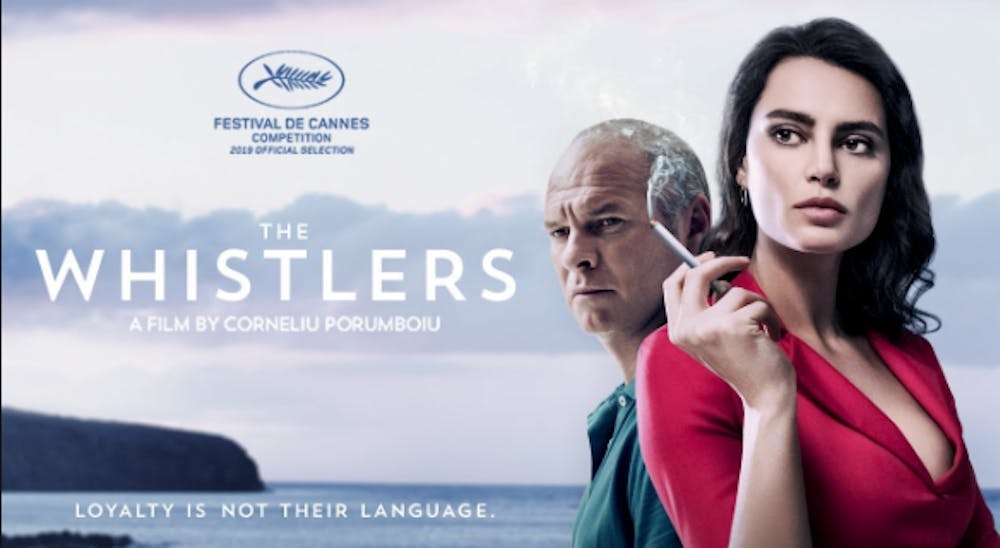Mafia movies have a unique reputation. On one hand, you may think of popular films directed by Coppola and Scorsese like “The Godfather” trilogy and “Goodfellas.” On the other, you might recall the wide assortment of parodied mafia tropes; everything from crude accents to dramatic chase scenes. Corneliu Porumboiu brings “The Whistlers,” a modern take on the genre, to the Hirschfield series. Packed with undertones of comedy and social commentary, “The Whistlers” delivers a curiously self-aware film with a dynamic cast and captivating set design and cinematography.
Set in Romania, the movie centers around Cristi (Vlad Ivanov), a police officer who also serves as a whistleblower for the mafia, providing them with police intelligence. Eying a hidden stash of 30 million euros that only fellow mafia member Zsolt knows the location of, Cristi and the mobsters work to free Zsolt from prison. To learn the mafia’s ancient language of whistling, Cristi goes to La Gomera, part of the Canary Islands. Under the tutelage of Paco (Augustí Villaronga), with much difficulty, Cristi learns to whistle with — and for — the gang.
The whistling language is seamlessly interwoven with a plethora of other languages in the film — English, Spanish and Romanian — to dramatize the different relationships between Cristi, the mob and their surrounding world. The blend of languages is particularly clever as characters in his orbit adopt different languages to convey different tones and emotions. For instance, while bird calls and whistles are wistful and bright, English is tense and jerky. Linguistically nuanced, “The Whistlers” provides viewers with a new approach to audio-visual storytelling.
Throughout the film, tension builds as Cristi’s fellow police officers grow increasingly suspicious of him, and he begins to crack under the pressure of looming interrogations. They set up cameras in his home, following him around through hidden lenses. Even at the start of the movie, Cristi has an inkling that his fellow police officers are suspicious of him. In a meetup outside his apartment, he informs Gilda (Catrinel Marlon), a fellow member of the gang, of his suspicions and the two take measures to be inconspicuous. Rather comically, Porumboiu sets up a scene in which Gilda demands Cristi to play along and act as if she were a “high-end prostitute” he hired, tauntingly staring into the hidden cameras as the cinematography allows the audience to dance along with the two. Integral to concealing their mafia connections, both are remarkably good actors, something even Cristi’s employer at the police department remarks.
A rather fascinating part of the movie is its set design and cinematography. Split into various acts, the film cuts between scenes with bright headers announcing the names of characters from whose perspective the scene is told (think Wes Anderson). From “Paco” and “Gilda” to “Mama,” the list goes on. These vignettes weave into one grand heist, eventually leading into Cristi’s story.
As interesting as the divisions were, they were used at the cost of effectiveness. Bright, neon colors, like those used in the character title cards, typically hint at a more upbeat film. Albeit occasionally humorous and tongue-in-cheek, the film was not quite dramatic enough to warrant the choice, disrupting its visual consistency. Between sparse humor and traditional thriller traits, the movie falls a bit short of balance.
Apart from these cutscenes, the film is gorgeous. “The Whistlers” employs an impressive array of scenery and contrasts it with the harsh reality of a police chase. The sound design is beautifully incorporated. By the seaside, in gardens and around plenty of nature, the language of the mob is almost beautiful as it blends into its natural surroundings. Bird calls bring a melodious and complex undertone to the relationships between mafia members, highlighting their complex group dynamics and showcasing a different side of the harsh tropes we’re used to seeing. With numbers such as Offenbach’s Barcarolle and Can-Can, the film’s deliberate musical decisions soften the image of our main characters. Especially within this genre, the push to create a new, offbeat tale is understandable. Despite compromising its consistency with experimentation, “The Whistlers” presents a commendable effort with a dramatic take on crime.
Reel Critic: 'The Whistlers'

Comments



